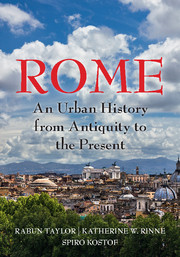Book contents
- Frontmatter
- Dedication
- Epigraph
- Contents
- List of Illustrations
- Acknowledgments
- Map
- INTRODUCTION
- 1 A BEND IN THE RIVER
- 2 A STORYBOOK BEGINNING
- 3 IDEOLOGICAL CROSSFIRE
- 4 BIG MEN ON THE CAMPUS
- 5 RES PUBLICA RESTITUTA
- 6 MEMORIALS IN MOTION: SPECTACLE IN THE CITY
- 7 THE CONCRETE STYLE
- 8 REMAKING ROME'S PUBLIC CORE: I
- 9 REMAKING ROME'S PUBLIC CORE: II
- 10 CRISIS AND CONTINUITY
- 11 RUS IN URBE: A GARDEN CITY
- 12 ADMINISTRATION, INFRASTRUCTURE, AND DISPOSAL OF THE DEAD
- 13 MAPPING, ZONING, AND SEQUESTRATION
- 14 TETRARCHIC AND CONSTANTINIAN ROME
- 15 TROPHIES AND TITULI: CHRISTIAN INFRASTRUCTURE BEFORE CONSTANTINE
- 16 WALLS MAKE CHRISTIANS: FROM FOURTH TO FIFTH CENTURY
- 17 A TALE OF TWO ROMES
- 18 THE ROME OF GOTHS AND BYZANTINES
- 19 CHRISTIAN FOUNDATIONS
- 20 FROM DOMUS LATERANI TO ROMANUM PALATIUM
- 21 THE LEONINE CITY: ST. PETER'S AND THE BORGO
- 22 VIA PAPALIS, THE CHRISTIAN DECUMANUS
- 23 THE URBAN THEATERS OF IMPERIUM AND SPQR
- 24 HOUSING DAILY LIFE
- 25 CHAOS IN THE FORTIFIED CITY
- 26 THE TIBER RIVER
- 27 HUMANIST ROME, ABSOLUTIST ROME (1420–1527)
- 28 PLANNING COUNTER REFORMATION ROME
- 29 PROCESSIONS AND POPULATIONS
- 30 MAGNIFICENT PALACES AND RHETORICAL CHURCHES
- 31 NEOCLASSICAL ROME
- 32 PICTURING ROME
- 33 REVOLUTION AND RISORGIMENTO
- 34 ITALIAN NATIONALISM AND ROMANITÀ
- 35 A CITY TURNED INSIDE OUT
- Glossary of Persons, Places, and Terms
- Works Cited
- Index
14 - TETRARCHIC AND CONSTANTINIAN ROME
Published online by Cambridge University Press: 05 July 2016
- Frontmatter
- Dedication
- Epigraph
- Contents
- List of Illustrations
- Acknowledgments
- Map
- INTRODUCTION
- 1 A BEND IN THE RIVER
- 2 A STORYBOOK BEGINNING
- 3 IDEOLOGICAL CROSSFIRE
- 4 BIG MEN ON THE CAMPUS
- 5 RES PUBLICA RESTITUTA
- 6 MEMORIALS IN MOTION: SPECTACLE IN THE CITY
- 7 THE CONCRETE STYLE
- 8 REMAKING ROME'S PUBLIC CORE: I
- 9 REMAKING ROME'S PUBLIC CORE: II
- 10 CRISIS AND CONTINUITY
- 11 RUS IN URBE: A GARDEN CITY
- 12 ADMINISTRATION, INFRASTRUCTURE, AND DISPOSAL OF THE DEAD
- 13 MAPPING, ZONING, AND SEQUESTRATION
- 14 TETRARCHIC AND CONSTANTINIAN ROME
- 15 TROPHIES AND TITULI: CHRISTIAN INFRASTRUCTURE BEFORE CONSTANTINE
- 16 WALLS MAKE CHRISTIANS: FROM FOURTH TO FIFTH CENTURY
- 17 A TALE OF TWO ROMES
- 18 THE ROME OF GOTHS AND BYZANTINES
- 19 CHRISTIAN FOUNDATIONS
- 20 FROM DOMUS LATERANI TO ROMANUM PALATIUM
- 21 THE LEONINE CITY: ST. PETER'S AND THE BORGO
- 22 VIA PAPALIS, THE CHRISTIAN DECUMANUS
- 23 THE URBAN THEATERS OF IMPERIUM AND SPQR
- 24 HOUSING DAILY LIFE
- 25 CHAOS IN THE FORTIFIED CITY
- 26 THE TIBER RIVER
- 27 HUMANIST ROME, ABSOLUTIST ROME (1420–1527)
- 28 PLANNING COUNTER REFORMATION ROME
- 29 PROCESSIONS AND POPULATIONS
- 30 MAGNIFICENT PALACES AND RHETORICAL CHURCHES
- 31 NEOCLASSICAL ROME
- 32 PICTURING ROME
- 33 REVOLUTION AND RISORGIMENTO
- 34 ITALIAN NATIONALISM AND ROMANITÀ
- 35 A CITY TURNED INSIDE OUT
- Glossary of Persons, Places, and Terms
- Works Cited
- Index
Summary
THE “ROMAN RECOVERY” OF DIOCLETIAN (284–305) AND THE TETRARCHY he established with his colleague Maximian (286–305) and two junior emperors, Galerius and Constantius Chlorus, are significant milestones in Roman history, changing the social structures of Roman life irreversibly. Their effects on the city are hard to read except in one sense: the imperial brickworks were reorganized and the mighty machine of the cura operum publicorum, the public works commission, sprang back into action – only now the artisanate operated under compulsion. For a while the imperial granite and porphyry quarries in Egypt again filled orders from Rome for large columns, statues, and sarcophagi. The material benefits of this minor renaissance accrued mostly to the monumental center. In 283 Rome experienced another damaging fire, this one at the Forum's northwest end. Diocletian and Maximian restored the Curia and parts of the adjacent Forum of Caesar, the Temple of Saturn, the Basilica Julia, and the Rostra, eventually augmenting the latter in 304 with five statue-crowned columns celebrating the current tetrarchs and, at the center, Diocletian, who retired that year after two decades as emperor. The opposing Rostra in front of the Temple of Divus Julius also acquired columns on a similar scale, and the southwestern flank of the Forum too (Figs. 91, 92).
This kind of attention to the city was only to be expected. But the crowning glory of Diocletian's building program was a monument of munificence: a vast bath-gymnasium complex on the Viminal plateau modeled on those of Trajan and Caracalla (Figs. 93, 94). Its water supply, an augmentation of the Aqua Marcia, represented the first significant improvement to the aqueduct system in 80 years. The architecture's state of preservation is stunning; today the central bath block hosts the church of S. Maria degli Angeli and the Museo delle Terme. The colossal granite columns and most of the vaulting in the church's transept, formerly the central frigidarium, are original. Almost the entire footprint of the complex and many of its vaulted halls remain impressed in the modern city fabric. Piazza della Repubblica itself is defined by the huge semicircular exedra of the baths’ southwest platform (Fig. 94).
- Type
- Chapter
- Information
- RomeAn Urban History from Antiquity to the Present, pp. 132 - 141Publisher: Cambridge University PressPrint publication year: 2016



